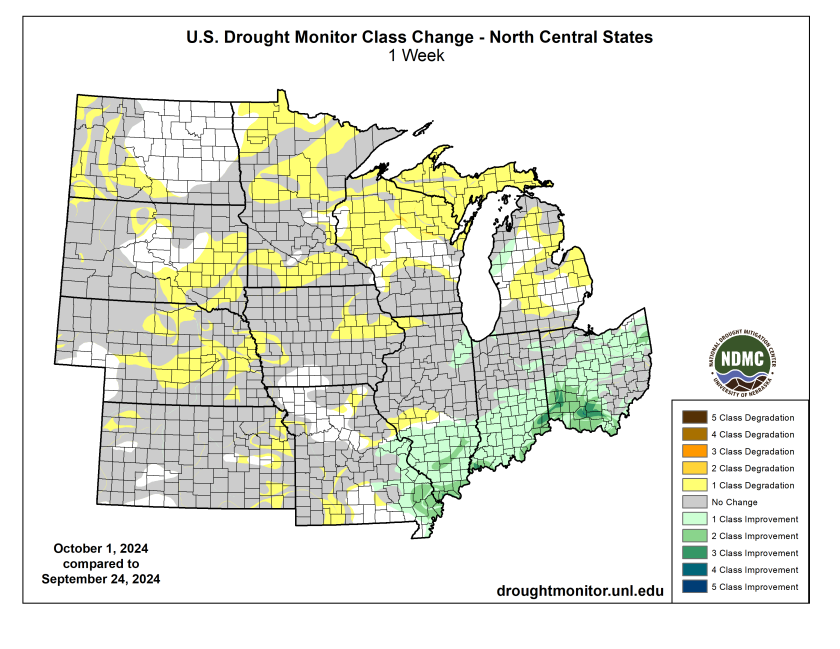WORTHING, S.D. — Fires are unfortunately common this season across the northern Plains as farmers are out in the fields in hot, dry, dusty conditions.
As of Thursday, Oct. 3, North Dakota issued a statewide fire emergency to respond to rapid wildfires. In this week alone, the state has reported over 67 fires burning 3,500 acres.
ADVERTISEMENT
“Above average temperatures, gusty winds, low humidity and significant amounts of dry vegetation have combined to create high fire danger conditions in parts of North Dakota,” North Dakota Gov. Doug Burgum said in a news release. “Fires can spread rapidly under these conditions, and the state is ready to respond quickly with resources as needed to help local firefighters and first responders protect lives, homes and communities.”

Much of Minnesota is listed as “high” fire danger, with portions of west central and northwest Minnesota listed as "very high" fire danger.
In South Dakota, a majority of the state is ranked at “very high” danger for grassland fires as of Friday, Oct. 4, according to the National Weather Service. Three counties were noted as having an .
On Sept. 30, Platte firefighters responded to nine fires alone.

In the southeastern portion of South Dakota, fires have been occurring, but not as extreme. A field fire in Worthing occurred on Tuesday, Oct. 1, and burned around 30 to 40 acres of soybeans and corn. It was caused by lost hydraulics spraying over the exhaust.
“By the time it got going, it was just fully engulfed,” said Worthing Community Fire Chief Justin Appel. “It spread quite quickly until they got some disks around it to make a fire break.”
One thing farmers can do to help fire departments is to have their disks hooked up to their tractors and ready to go in case a fire does spark. Disks can help create fire blocks in the field.
ADVERTISEMENT
“What that does is it puts the crops underneath the ground so we can stop it from spreading,” Appel said. “If a fire does start, definitely have a disk ready to go, that way we can utilize that and have you guys go around and help us knock this down.”

It's also important to have fire extinguishers on the equipment. If farmers have water tanks, they are also encouraged to have those full and on location or close to the field.
“If you do have a fire on your combine, have a fire extinguisher with you, get it out,” Appel said. “If you notice that it is started up again, call right away. Don’t try to put it out yourself. With this wind, it’s just going to keep going and you’re not going to catch up to it.”
If farmers are prepared for helping to stop fires, they can get a head start before the fire departments arrive.
“With field fires, we want farmers to help any way they can help us and just get resources to come to the fire as quick as we can,” said Harrisburg Community Fire Chief Cody Lengkeek.

The Harrisburg Community Fire Department posted on Facebook asking if farmers in the area would be willing to help in case of a field or large grass fire. They asked those farmers to have disks hooked up and water tanks available on standby.
“We are just trying to compile a list of resources that we can call in the event that there is a larger field fire or even a grass fire. Any help is greatly appreciated,” Lengkeek said. “All volunteer fire departments around the state of South Dakota, they’re three to four guys during the day, like Harrisburg and the surrounding area, Worthing, there’s only a couple people around during the day and everybody’s working in Sioux Falls, so any help is greatly appreciated.”
ADVERTISEMENT
When it comes to preventing a fire, equipment operators should properly prepare their machines before entering the fields.
“Greasing your bearings,” Lengkeek said. “If you do have loose belts, definitely get everything tightened up and just general maintenance on the equipment.”
“A lot of main causes would be bearings, bad bearings. Also, faulty hydraulics spraying on exhaust,” Appel said.
If you do have a fire in your field, call 911.












